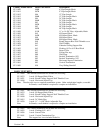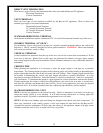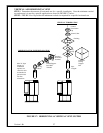
INSTALLATION PLAN
VENT (FRESH AIR) REQUIREMENTS
The Bayvue DV burns fuel by combining the proper amount of natural gas or propane with fresh air to
obtain complete combustion. During heavy natural gas demand periods (extremely cold consecutive days)
the local gas supplier may provide “filler gasses” with the natural gas fuel supply. This mixed gas may
cause a change in burner flame appearance. This may cause soot to form on the logs and viewing
windows. In the event any change in the burn pattern is noticed, contact the local gas supplier to obtain
additional information and contact a certified professional to clean and adjust the appliance, if necessary.
It is imperative to ensure delivery of the proper amount of fresh combustion air to gas appliances. The
Bayvue DV (direct vent) chimney system brings all combustion fresh air requirements through a dual
chimney pipe and exhausts the spent combustion gasses back through the chimney pipe system. Failure to
properly seal the direct vent chimney system will allow leaks that will prevent the proper amount of fresh
air from being available for combustion or can potentially leak harmful combustion gasses back into the
home. Failure to provide adequate combustion air will cause operational problems, increased maintenance
issues, and potential failure of the gas stove to perform to its designed standard. For specific details on
combustion air requirements, refer to the current NFPA-54 (natural gas) or NFPA-58 (propane) and the
current ANSI Z223.1 standards. Although direct vent gas appliances are designed to minimize fresh air
issues, the homeowner should understand fresh air requirements for all fuel burning appliances in a home
and also understand the interaction these appliances can have on each other and the availability of fresh air
in the home. The next several paragraphs explain and provide examples of fresh air issues.
Modern construction techniques are making new homes tighter and tighter to air infiltration. This is good
in one sense as it reduces the amount of energy required to maintain a home at a comfortable temperature;
however, this is bad in another sense because without an adequate fresh air supply, these new air tight
homes become “stale or depleted of fresh air.” Most new airtight homes come with air exchange systems
that replace inside home air with fresh outside air so many times an hour. This air exchange system is
balanced to the number of occupants and the fuel burning appliances located in the home. If additional
combustion devices are added to a home, a certified professional should rebalance the air exchanger.
Rebalancing the system adjusts for the fresh air usage of any new combustion appliance. Rebalancing the
air exchanger ensures proper amounts of fresh air for the home occupants and other appliances. If your
home contains an air exchange system, contact a local certified professional to have a fresh air analysis
done while the Country Flame appliance is being installed.
A homeowner needs to understand the terms “restricted” and “unrestricted” air space. Even though
properly installed direct vent chimney systems eliminate combustion air requirements there is still the
requirement for ventilation air. If a home is not air tight, depending on room configuration and other fresh
air barriers, a gas appliance can still be installed in too small a room and “starved or restricted” from
receiving the proper amount of necessary air. Again, this is not true of Direct Vent appliances whose
chimneys provide for combustion air; however, direct vent appliance chimney systems do not provide for
ventilation air requirements. Determining the amount of fresh air available to a gas appliance is a
relatively easy mathematical exercise. Get out the old calculator and follow the examples provided. First,
here are the “official” definition of terms:
a) Space: a room where a gas appliance is to be placed. The total space required to ensure proper
fresh air to a gas appliance can include additional space or room(s) if there is no restriction to airflow
between the space(s) or room(s). “Unrestricted” space means (i) no closable doors can exist between
rooms or (ii) there must be proper sized grills (non-closing) placed between adjoining spaces or rooms. If
closable doors exist or no grills exist between adjoining rooms, then the adjoining space next to where the
gas appliance is to be located cannot be included in the calculation to determine if adequate fresh air exists
for proper operation of the gas appliance.
Version 1.0h
22
b) Unrestricted space: is defined as an area that provides at least 50 cubic feet of air volume for
each 1,000 Btu per hour of input heat rating of a gas appliance. The 50 cubic feet of fresh air volume is
made up of primary (combustion) and secondary (heated) air requirements. Vented gas appliances use 10


















